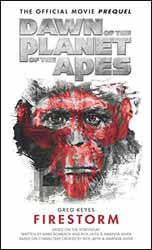|
Click here to return to the main site. Book Review
With the imminent arrival of Dawn of the Planet of the Apes, it is no surprise that merchandise is starting to rear its head. The film shows events after the fall of man and the establishment of Caesar’s surviving apes in their new home. This of course leaves a very big gap in the story which a new tie-in novel hopes to breach. Dawn of the Planet of the Apes: Firestorm, written by American novelist, Greg Keyes, who is no stranger to genre tie-in books having penned the excellent Psi Corp trilogy for Babylon 5. He is also the author of his own original fiction. The book opens scant weeks following the events in Rise of the Planet of the Apes (2011), with Caesar and his group still on the run from the humans, who have already started to succumb to the simian flu, which has a high mortality rate. Unsure of whether the apes are actually causing the pandemic, the authorities are hot on their trail, whilst at the same time trying to cover up or downplay what is really happening. Keyes has taken an unusual approach with the novel. Like many, I thought that the novel would concentrate on Caesar, placing him in the middle of the action; in fact he appears relatively infrequently. The ape which gets the most exposure is Koba, the one-eyed aggressive chimp from the first film. Through the length of the book we learn his back story and the reason he hates humans. As far as I can tell, apart from a single human character, Dreyfus, who would go one to lead the surviving humans in Dawn of the Planet of the Apes (2014), the remaining characters exist only for this novel. Keyes has a dual task in the book, to tell how and why the apes are finally left to their own devices and just how they planned to survive in an environment they are not naturally adapted for and how the human society succumbed and crumbles under the dual weight of the simian flu and their own stupidity. To chronicle the events in the human world, Keyes introduces us to an investigative journalist, David Flynn, whose inquisitiveness leads him into the darker side of human society to people who will kill to keep their secrets. What happens to the apes is primarily told from the perspective of Malakai who is drafted in, due to his expertise in hunting chimps, who very quickly realises that the chimps they are hunting are not normal. Other characters are introduced to give us a wider perspective of what is happening in the hospitals and corridors of power as the flu takes hold, threatening man’s very existence. It’s an unusual choice to side-line your main character, but I can see why the author did it. Had you watched the first film then you know Caesar's backstory, which makes it redundant to reproduce it in another story. As Koba was one of the stand-out chimps it makes sense to shift the perspective to him. Likewise, the humans who are introduced are, ultimately, disposable, except for Dreyfus, who becomes a character in the new film. And while this is set just weeks following the first film, the second moves the story forward by ten years. So, it’s an unexpected twist to the expected tale, but worthy of a read none-the-less. 7 Charles Packer Buy this item online
|
|---|



